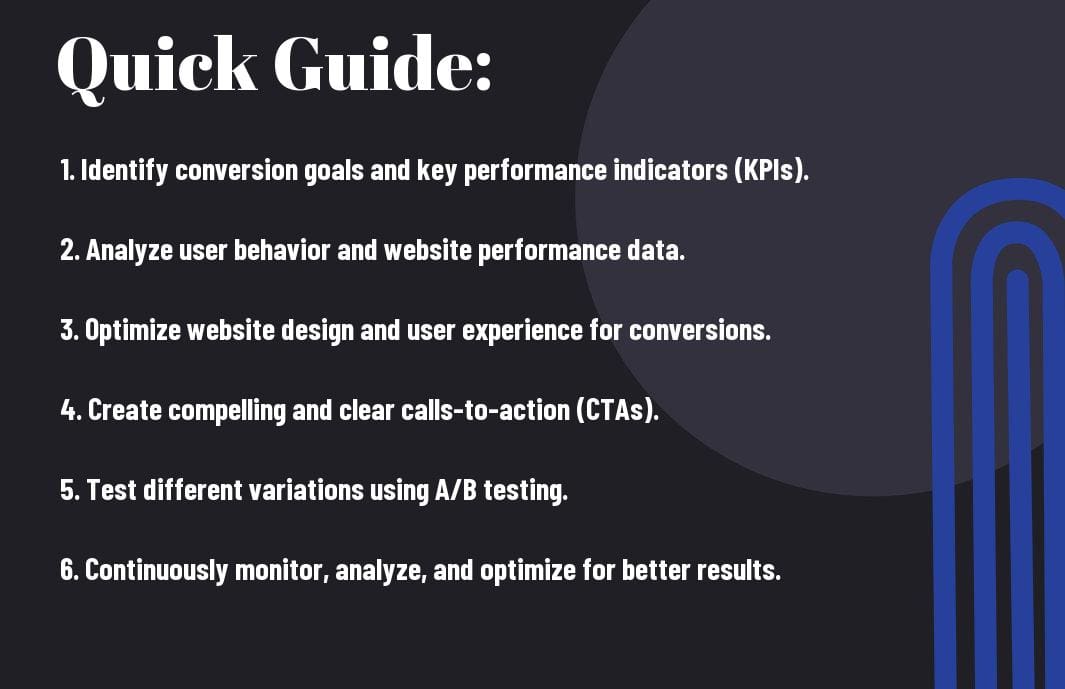Most businesses strive to increase their online conversions to drive revenue and growth. Understanding the intricacies of Conversion Rate Optimization (CRO) is crucial for achieving this goal. By implementing effective CRO strategies, businesses can enhance their website performance and boost conversions. This step-by-step guide will walk you through the critical elements of CRO, from identifying key performance indicators to implementing actionable tactics.
Key Takeaways:
- Understand Your Audience: Effective conversion rate optimization starts with a deep understanding of your target audience’s needs, behaviors, and preferences.
- Test and Analyze: Utilize A/B testing and analytical tools to track user behavior, identify pain points in the conversion funnel, and make data-driven decisions to optimize the conversion rate.
- Optimize Call-To-Actions: Make sure your call-to-actions are clear, compelling, and strategically placed to guide users towards the desired action, ultimately leading to higher conversions.

The Essentials of Conversion Rate Optimization
Definition of Key Terms
If you’re looking to enhance your online presence and drive more conversions, understanding key terms in conversion rate optimization (CRO) is crucial. CRO is the systematic process of increasing the percentage of website visitors who take a desired action, whether that’s making a purchase, signing up for a newsletter, or filling out a contact form. Conversion rate is the ratio of conversions to visitors on your site, representing the effectiveness of your online performance.
Primary Components of CRO
Any successful CRO strategy revolves around analyzing, testing, and optimizing various elements on your website to improve conversion rates. The primary components of CRO include research and data analysis, user experience (UX) design, call-to-action (CTA) optimization, split testing, and conversion funnel optimization. By focusing on these crucial areas, you can identify areas of improvement and make data-driven decisions to boost conversions and enhance user satisfaction.
Rate Any changes or modifications made during the CRO process should be based on thorough analysis and testing to ensure they positively impact conversion rates. By continuously measuring and refining your CRO strategies, you can maximize the effectiveness of your website and drive meaningful results for your business.
Types of Conversions
Not all conversions are created equal. Understanding the different types of conversions is important for a successful conversion rate optimization strategy. There are two main types of conversions to consider: Macro-Conversions and Micro-Conversions.
| Macro-Conversions | Micro-Conversions |
| Primary conversions that directly impact your bottom line. | Secondary conversions that lead to macro-conversions. |
| E.g., Product purchases, lead form submissions. | E.g., Email sign-ups, social media follows. |
| Examples of macro-conversions include sales, sign-ups, and downloads. | Examples of micro-conversions include newsletter subscriptions, social media shares, and blog post views. |
Macro-Conversions
The primary conversions that directly impact your bottom line are known as macro-conversions. These are typically actions that result in revenue generation for your business, such as product purchases or lead form submissions. It is crucial to focus on optimizing these conversions to improve overall profitability and success.
Micro-Conversions
Assuming you have optimized your macro-conversions, it’s time to pay attention to micro-conversions. These are secondary conversions that may not directly result in revenue but play a critical role in guiding users towards the primary conversions. Micro-conversions can include activities like email sign-ups, social media follows, or content downloads.
It is important to note that micro-conversions can be just as vital as macro-conversions in the customer journey. These actions help build relationships with visitors, increase brand engagement, and ultimately influence their decision-making process. By optimizing both macro and micro-conversions, you can create a holistic strategy that drives sustainable growth for your business.
Factors Influencing Conversion Rates
To boost your conversion rates, it’s crucial to understand the key factors that influence user behavior on your website. From website design to call-to-action elements, various aspects can either drive or deter conversions. By optimizing these factors, you can create a seamless user experience that compels visitors to take the desired action.
- Website Design and User Experience: For a successful conversion rate optimization strategy, your website design and user experience play a fundamental role. A well-designed website with intuitive navigation, appealing visuals, and fast loading times can significantly impact how users engage with your content and ultimately convert.
- Content Relevance and Clarity: There’s no underestimating the power of relevant and clear content in influencing conversion rates. Your content should not only be informative and engaging, but also directly address the needs and pain points of your target audience. By crafting compelling and easy-to-understand content, you can guide visitors towards conversion.
Content Relevance and Clarity
There’s a direct correlation between the relevance and clarity of your content and the likelihood of conversion. Ensure that your messaging is tailored to your target audience, addressing their specific challenges and offering solutions that resonate with them. Clear and concise content can help build trust and credibility, making visitors more inclined to take action.
Call-to-Action (CTA) Elements
Influencing your audience to take the desired action on your website hinges on the effectiveness of your Call-to-Action (CTA) elements. By strategically placing compelling CTAs that clearly communicate the next steps, you can guide visitors towards conversion. A/B testing different CTAs can help determine which ones resonate best with your audience.
Clarity: Make sure your CTAs are clear, concise, and visually appealing to grab the attention of visitors. Avoid vague language and ensure that the CTA stands out on the page, prompting users to take immediate action.
Trust Signals and Social Proof
On your website, incorporating trust signals and social proof can help alleviate any doubts or concerns visitors may have about your brand or offerings. Testimonials, client reviews, trust badges, and case studies can all contribute to establishing credibility and trust with your audience, ultimately increasing conversion rates.
Page Load Speed and Technical Performance
Proof:
With mobile devices becoming the primary means of accessing websites, it’s crucial to ensure that your website loads quickly and performs well across all devices. Slow loading times or technical errors can result in a poor user experience, leading to high bounce rates and low conversions. By optimizing your website’s performance and addressing any technical issues, you can provide a seamless browsing experience that encourages visitors to convert.
Step-by-Step Guide to Conversion Rate Optimization
| Identifying Conversion Goals | Analyzing Existing Data |
| Assuming you have clear business objectives, the first step is to identify your conversion goals. These goals could include increasing sales, generating leads, or boosting sign-ups. By defining these goals, you can align your optimization efforts towards achieving them. | One of the crucial steps in the conversion rate optimization process is analyzing existing data. By examining metrics such as traffic sources, bounce rates, and conversion funnels, you can pinpoint areas that need improvement. This analysis lays the foundation for your optimization strategy. |
Conducting Qualitative and Quantitative Research
Another part of the conversion rate optimization process involves conducting qualitative and quantitative research. Businesses can gather insights through methods such as surveys, user testing, heatmaps, and session recordings.
Conducting thorough research allows you to understand user behavior, preferences, and pain points. By combining qualitative feedback with quantitative data, you can gain a holistic view of your audience and tailor your optimization strategies accordingly.
Creating an Optimization Plan
It is crucial to create a structured optimization plan based on the insights gathered from research and data analysis. This plan should outline specific changes to be made on the website or landing pages to enhance the user experience and drive conversions.
One key aspect of creating an optimization plan is prioritizing changes based on their potential impact and resource requirements. By focusing on high-impact areas first, you can maximize the effectiveness of your optimization efforts.
Implementing CRO Strategies
Research shows that implementing conversion rate optimization strategies can significantly improve conversion rates and drive business growth. By optimizing call-to-action buttons, improving page load speeds, and enhancing user experience, businesses can create a more conversion-friendly environment.
Testing and Iterating
Now, it is time to test the implemented changes and iterate based on the results. A/B testing, multivariate testing, and usability testing can help identify what works best for your audience. By continually testing and refining your strategies, you can ensure ongoing improvements in conversion rates.
Optimization is an ongoing process that requires a combination of data-driven insights, strategic planning, and iterative testing. By following this step-by-step guide to conversion rate optimization, businesses can maximize their online potential and drive sustainable growth.
Tips for Effective Conversion Rate Optimization
Now, boosting conversions requires a strategic approach to Conversion Rate Optimization (CRO). To improve your website’s conversion rates, it is vital to follow best practices in website design, crafting compelling copy, optimizing forms and checkouts, and implementing personalization strategies. These key elements work together harmoniously to enhance user experience and drive more conversions on your website. Perceiving the various components of CRO and implementing them effectively can make a significant impact on your conversion rates.
Best Practices in Website Design
An aesthetically pleasing and user-friendly website is crucial for conversion rate optimization. A clutter-free design with easy navigation helps visitors find what they are looking for effortlessly. Responsive design ensures seamless user experience across all devices, improving engagement and conversion rates.
Crafting Compelling Copy
Designing engaging and persuasive copy is vital to guide visitors towards taking a desired action. Your copywriting should be clear, concise, and relevant to your target audience. By addressing pain points, highlighting benefits, and using persuasive language, you can compel visitors to convert.
Practices like creating catchy headlines, incorporating power words, and using storytelling techniques can captivate your audience and encourage them to explore further.
Optimizing Forms and Checkouts
Little tweaks in your forms and checkouts can have a significant impact on your conversion rates. Simplifying forms by reducing the number of fields and enabling auto-fill options can streamline the conversion process. Clear call-to-action buttons and progress indicators in checkouts can create a sense of urgency and encourage users to complete their purchase.
The checkout process should be seamless and secure, offering multiple payment options to cater to different preferences and needs. By optimizing forms and checkouts, you can eliminate friction points and provide a hassle-free experience for your customers.
Personalization Strategies
While personalization can enhance user experience and drive conversions, it is crucial to implement it effectively. By leveraging user data and behavior analysis, you can deliver tailored content, product recommendations, and offers that resonate with individual visitors. Personalized marketing messages based on past interactions can significantly increase engagement and conversion rates.
For instance, implementing dynamic content based on user preferences and browsing history can create a personalized experience that boosts conversions and fosters customer loyalty. By incorporating personalization strategies into your CRO efforts, you can create a more personalized and engaging experience for your audience.
Pros and Cons of Conversion Rate Optimization
All pros and cons information should be broken down into a




